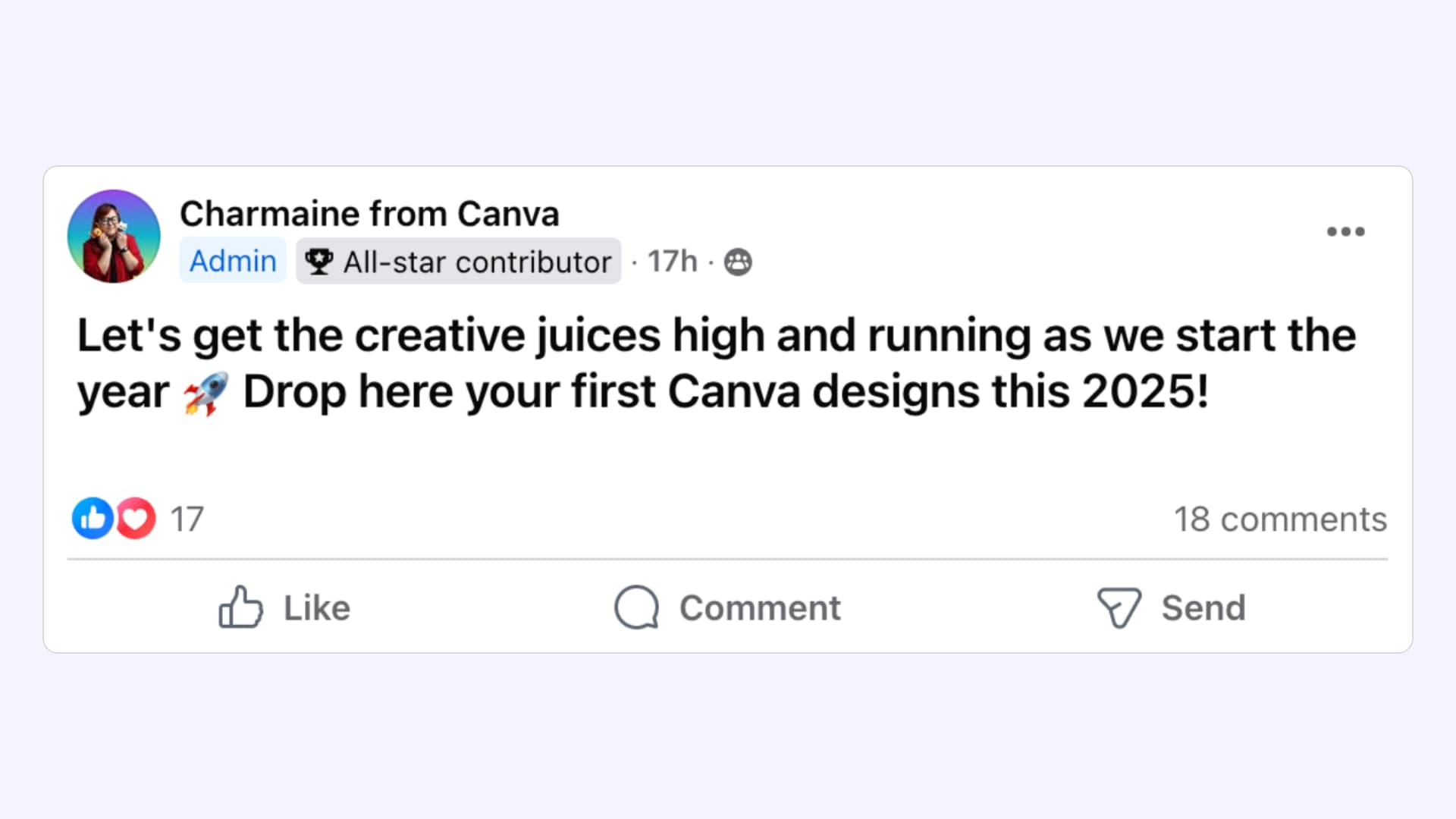Digital marketing has reached a tipping point: brands can no longer buy their way to customer loyalty. With AI-generated content flooding feeds and ad costs hitting record highs, authentic community engagement has become the last true competitive advantage.
The proof is in the numbers: The CMX 2024 Community Industry Report found that companies with active communities keep customers three times longer and get them using new products twice as fast. No wonder 83% of marketers are making community their top priority in 2025 – up from just 45% a few years ago.
Community management is a great way to build your online presence and increase brand advocacy through your fans and followers — you just need the right playbook.
What is community management?
Community management is how brands build and nurture relationships with their network of customers, fans, followers, partners, and employee advocates — both online and offline. These engaged community members help amplify the brand's message and organically grow awareness.
Community management can range from a core business function with a dedicated team, to just one part of your marketing mix. A comprehensive strategy includes these key components, though smaller brands may start with just one:
- Building connections between everyone in your ecosystem: customers talking to each other, employees engaging with customers, and even AI assistants (like chatbots) handling routine interactions
- Making participation worthwhile by highlighting user-generated content and offering exclusive perks for active members
- Learning from your community to spot trends, shape products, and understand what drives engagement
- Providing customer care, from solving immediate problems to preventing future issues through community-powered support
Your community can live anywhere your customers hang out — social media, chat apps, forums, or even in real life (like Bandit Running's local run clubs).
Choosing your community platform
When starting out with community management, resist the temptation to be everywhere at once. Pick one platform to master first — you can always expand later. Here's how to choose the right starting point:
Match your platform to your goals
Different platforms excel at different types of community engagement:
- Instagram/TikTok: Visual storytelling, behind-the-scenes content, quick engagement
- Facebook Groups: In-depth discussions, peer support, resource sharing
- LinkedIn: Professional networking, B2B relationships, thought leadership
- Discord/Slack: Real-time chat, technical support, special interest groups
Consider your audience's preferences
Your community platform should be where your audience already spends time:
- Gen Z gravitates toward TikTok and Instagram
- Professionals are active on LinkedIn
- Broader age groups use Facebook
- Gaming and tech-savvy audiences prefer Discord
Assess your resources realistically
What resources does your team have for building and managing your online community? Some platforms take more time, money, and effort than others, so you’ll want to keep that in mind.
Let’s walk through a few scenarios to consider:
- Time investment required per platform: If you already have an audience on Instagram, it may be faster to turn that audience into an engaged community versus a platform you have to start from scratch on.
- Content creation capabilities: If your team doesn’t have the capabilities to create video content, you’ll want to avoid platforms like TikTok or Instagram and instead focus on other options.
- Moderation needs: Platforms like Facebook Groups or Slack communities require moderation to ensure everyone is following the rules. If you don’t have resources to allow for that, you may want to focus on platforms that don’t need this, like Instagram or TikTok.
- Budget considerations: Beyond platform fees, you'll need to budget for team salaries, advertising to grow your audience, content creation, and community management software. If funds are tight, start with a free platform like Facebook Groups where you can create engaging content using basic tools.
- Team size and expertise: How many people do you have on your team that will be available to build and manage your platform? Keep that in mind so you don’t bite off more than you can chew.
The best advice is to start where you have the strongest foundation and resources now, and expand later as your community grows.
Platform-specific community management playbooks
Once you've chosen your platform, it's time to build your community strategy. While community management can happen anywhere—from in-person events to private forums—social media platforms have become the most common starting point for brands in 2025. They offer built-in audiences, robust engagement tools, and lower barriers to entry.
But social platforms weren't built specifically for community management, requiring brands to get creative with how they use available features. Let's look at how to adapt each platform's unique capabilities to create genuine community engagement.
Community management on Instagram
Instagram is a great place for visual brands to grow and manage their audience. In 2025, successful brands are moving beyond basic posting to create multi-layered engagement using these key features:
Instagram Stories: Your community hub
Instagram Stories are quick image, graphic, or video posts that stay on your profile for up to 24 hours. Users can save Stories to different highlight collections at the top of their profile for followers to look back on, and they come with a number of features that let you interact with your audience.
Here are a few ways to use Stories for community building:
- Daily engagement prompts: Run polls about product features, quiz followers about your industry, or use the emoji slider for quick feedback
- Behind-the-scenes content: Share workspace tours, product development updates, or team member spotlights that encourage questions and discussion
- Community spotlights: Feature customer success stories, user-generated content, or team member takeovers
- Interactive templates: Create shareable templates that prompt followers to participate and share with their networks
Comments: Your community gathering space
Another important part of community management is having a strategy for increasing comments and responding to them. You should always be interacting with those in your audience who interact with you. It keeps the conversation going and makes your followers more likely to continue engaging.
You can transform your comments section from a feedback dump into a vibrant discussion space by implementing some of these practices:
- Response strategy: Reply within an hour to top comments, and within 24 hours to all others
- Conversation starters: Ask follow-up questions that encourage deeper discussion
- Community connections: Tag relevant community members who might have insights to share
- Support routing: Direct customer service issues to DMs while keeping product discussions public
Instagram Broadcast Channels: Your VIP room
Think of your Broadcast Channel as an exclusive club for your most engaged followers. Once you start to get some members, you can share different types of content like:
- Early access: Preview new products or features
- Insider updates: Share company news before it goes public
- Exclusive content: Post tutorials, tips, or behind-the-scenes content
- Direct feedback: Use polls and prompts to gather quick insights from your most valuable community members
You can also invite collaborators, like brand ambassadors, to help you manage your community and share content, as well as create different channels for more niche topics. For example, a beauty brand might create one channel for makeup and another for hair care.
Additional engagement tools
Instagram offers several other community-building features worth exploring. Use Close Friends to create an exclusive tier for VIP customers, Instagram Notes for quick community updates, and Lives for real-time events like Q&As or product tutorials. Better yet, combine these features strategically — for example, using Notes to promote upcoming Lives, then saving the recording to Close Friends Stories for those who couldn't attend.
Community management on Facebook
Facebook Groups remain the platform's strongest community-building tool in 2025. Unlike other social platforms, Groups are purpose-built for community interaction, with features designed specifically for ongoing discussions and member engagement.
Use these tips to make the most out of your Facebook Group.
Create engaging discussion formats and prompts
Your first goal is to create content that gets your group members active and interested in the community and its posts. Theme your posts around your community's interests — industry news on Mondays, member spotlights on Wednesdays, or weekly challenges that encourage participation. Mix educational content with lighter engagement posts to keep the energy high.
Take a look at how Canva’s group admins engage their audience, using posts like this one below:
Manage member roles and permissions
Facebook Groups also let you create and manage different member roles and permissions. Set admins, moderators, or other roles that make it easier to create a community leadership structure. You can add a gamification element to these roles, recognizing active members while distributing moderation duties across your most trusted participants.
Going back to Canva’s group as another example, the brand community has created a custom role called “Canvassador.” Essentially, these are volunteer brand ambassadors who help keep the group engaged and running smoothly.
Host virtual events and live sessions
Facebook Groups also enable you to host group-specific events and live broadcasts. Host monthly Q&As, bring in industry experts for live sessions, or create member-only workshops. The key is to make these events interactive—encourage questions, use polls during broadcasts, and follow up with post-event discussions.
Use Facebook Group insights effectively
Your Facebook Group Insights help you understand what drives engagement. Track which posts generate the most interaction, when your members are most active, and who your top contributors are. Use these insights to refine your content strategy and identify potential community leaders.
Community management on TikTok
TikTok is another great platform for building your community as its users tends to be active and engaged. You simply need to employ the right tactics for increasing engagement within your own content.
Comment-driven content strategy
Turn your comments section into a content engine. When followers ask questions or make suggestions, respond with full videos instead of text. This not only answers the original commenter but creates valuable content for your wider audience. Outdoor retailer REI masters this approach, regularly creating gear tutorials based on customer questions.
The brand also has a strategy for responding to comments in an effort to bring new viewers into its TikTok community. Take a look at just some of the comments on one of their viral Wicked-themed posts to see how REI responded:
Duets and Stitches
These features are your secret weapon for community building. Use Duets to showcase customer success stories, react to user reviews, or collaborate with community members. Stitches work perfectly for adding expert context to user questions or building on community ideas. Beauty brands like Fenty excel here, regularly duetting makeup tutorials from their community.
Live strategy
TikTok Lives work best as casual, behind-the-scenes moments rather than formal presentations. Use them for product sneak peeks, Q&As, or live tutorials where your community can guide the content. The most successful Lives feel like FaceTime calls with friends rather than broadcast events.
User-generated content and trends
One of the best ways to build community is by sharing content from your audience. When customers or creators post videos about your brand, you can reshare them (with permission, of course).
For example, Nespresso often shares coffee-related videos from creators — even when their products aren't specifically mentioned. This works because the content still connects with their coffee-loving audience.
The key is finding and sharing authentic content that your community will relate to, whether it directly features your products or just aligns with your brand's overall theme.
TikTok Q&A
TikTok has a Q&A feature that lets your audience ask questions that you can then answer in comments or with a response video. If you turn this feature on, a Q&A link will appear in your TikTok profile and a question box icon will appear next to your comments.
Promote your Q&A box with your video content to get your audience asking questions they might have. Make sure to create video responses to the best or most popular questions as a way to further engage your viewers.
Community management on LinkedIn
LinkedIn community management requires a different approach from other platforms. In 2025, successful B2B communities on LinkedIn blend thought leadership, employee advocacy, and strategic content distribution. Use these tactics to help.
Comment sections as micro-communities
Transform your post comments into valuable discussion spaces. Instead of just responding to comments, facilitate conversations between commenters by tagging relevant experts and asking thought-provoking follow-up questions. HubSpot excels at this, turning simple posts into industry-wide discussions.
Employee advocacy program
Your employees are your secret community-building weapon. Empower team members to share insights, behind-the-scenes glimpses, and industry perspectives. Mailchimp's content team demonstrates this perfectly — their personal posts about marketing trends consistently outperform the official brand account but still spread considerable brand awareness.
Newsletter strategy
While LinkedIn newsletters don't facilitate direct conversation, they're powerful for nurturing community interest. Use them to spark discussions that continue in post comments. Share exclusive insights, then encourage subscribers to contribute their own experiences.

Events and live sessions
LinkedIn Live sessions work differently from other platforms. Focus on structured discussions with clear takeaways rather than casual chats. The most successful B2B communities host monthly expert panels or Q&As that combine education with networking opportunities.
Other community management platforms
The social media platforms we’ve listed aren’t your only options. There are other platforms built to create communities that may take more time and resources to manage, but can be great options.
Messaging apps as community hubs
Messaging platforms like Slack and Discord have become go-to spaces for building engaged communities. These apps are particularly good at creating meaningful connections because they enable real-time conversations in a more relaxed environment. Here’s how to approach them:
- Professional communities: Paid Slack communities like Superpath have transformed how professionals network and grow. Content marketers pay for access to expert advice, job opportunities, and peer networking — creating a high-value space that's more focused than traditional social media.
- Customer support communities: Tech companies increasingly use these platforms for customer support and peer-to-peer engagement. Notion has several unofficial Discord communities that let users share templates, troubleshoot problems, and get peer help faster than traditional support channels.
Email and newsletter communities
Email marketing has evolved beyond one-way broadcasts into a legitimate community-building channel. Modern email platforms offer features that transform subscriber lists into engaged communities. For example, beyond newsletters, Substack's "Notes" feature enables Twitter-like discussions between writers and readers, while their recommendation network helps cross-pollinate communities.
Measuring your community engagement efforts
Community management requires a different approach to measurement than traditional social media metrics, allowing for both qualitative and quantitative results. While follower counts and comment volumes matter, real impact happens when your community starts taking on a life of its own.
Consider more nuanced KPIs to track community management, like:
- Community health: Look for signs of organic interaction between members, the emergence of community leaders, and overall brand sentiment in discussions. A healthy community becomes self-sustaining, with members helping members and initiating conversation.
- Business impact: Connect community activity to business goals. This might mean tracking customer retention rates among community members, seeing how many customer service issues get solved by the community (saving your support team time), or monitoring how quickly members adopt new features.
- Member value: Assess what members gain from participation. Are they finding solutions faster? Making valuable connections? Getting exclusive insights? These qualitative benefits often drive the most meaningful engagement.
Create your community management strategy today
Start building your brand community today, and let Loomly help with your community management. From unified inboxes to approval workflows so your team can collaborate, we’ve got plenty of features that make managing your online presence a breeze.


.jpg?width=500&height=750&name=2025%20community%20management_Instagram%20stories%20strategy%20(2).jpg)










